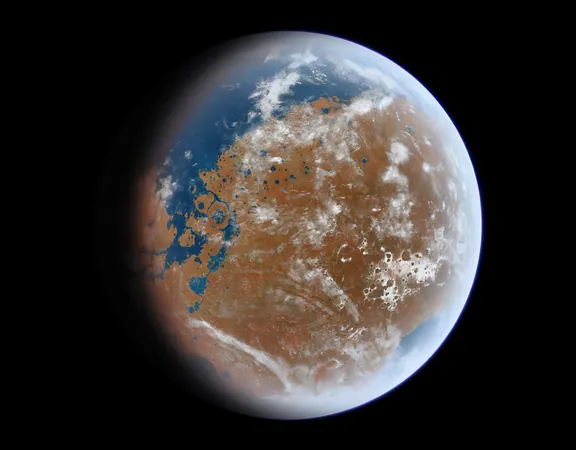
Mars' Water Mystery: Scientists Unravel the Hidden Journey
2025-05-21
Author: Benjamin
Unlocking Mars' Water Secrets
Once, rivers carved channels across Mars' surface, but where did all that water go? A groundbreaking study from graduate researchers at The University of Texas at Austin has connected the dots, illuminating the relationship between ancient rain-fed lakes and a hidden groundwater reservoir lying about a mile beneath the surface.
The Slow Dance of Groundwater
Using advanced computer models, researchers Mohammad Afzal Shadab and Eric Hiatt uncovered the slow migration of water through Martian soil, revealing that it took between 50 to 200 years for surface water to seep into a deep aquifer. In contrast to Earth, where this process can happen within days, Mars’ water travels at a glacial pace—a significant discovery for understanding the planet's ancient hydrology.
Where Did the Water Go?
Taking their model further, the scientists estimated that lost water could have blanketed Mars with about 90 meters (300 feet) of water. With evidence suggesting that Mars once harbored a vast ocean, this finding indicates a substantial depletion of the planet's original water supply.
A One-Way Trip
On Earth, the water cycle is a self-sustaining loop facilitated by evaporation and rainfall. However, Mars appears to have operated quite differently. The findings point to a one-way journey—water drained into the crust, became trapped in pores and minerals, while a thin atmosphere lost remaining vapor to space.
Implications for Habitability
The duration that liquid water existed on Mars is critical for understanding its potential to host life. Stable water sources are essential for many prebiotic reactions and microbial activities, raising questions about how long water could have persisted on the Martian surface.
Decoding Mars' Ancient Hydrology
Using data from Martian meteorites and rover observations, Shadab and Hiatt simulated early Martian soils as a porous medium. By analyzing a range of environmental factors, they identified the varying travel times and volumes of infiltrated water, which were significantly prolonged due to Mars' lower gravity and cold temperatures.
Bridging the Understanding of Water Loss
Their research aligns with findings that much of Mars' crust is rich in hydrated minerals and buried ice, while over half of the planet's original water likely escaped to space. By calculating the flow of water from lakes to the ground, they provide a clearer picture of Martian hydrology.
Future Exploration and Discoveries Await
Shadab, now conducting postdoctoral research, aims to integrate this knowledge with climate simulations that encompass rainfall and volcanic activity. This combined framework could provide insights into the existence of ancient oceans or the aftermath of catastrophic flooding.
A Planet with Short-Lived Water
The new findings portray Mars as a world where surface water had a fleeting existence. Unlike Earth, with its efficient water recycling system, once Martian water sank below ground, it was essentially lost forever. This compelling research not only enhances our understanding of Mars' watery past but also sets the stage for future missions that may directly explore its hidden aquifers.
Get ready for exciting discoveries ahead as scientists continue to unravel the mysteries locked beneath Mars' surface!









 Brasil (PT)
Brasil (PT)
 Canada (EN)
Canada (EN)
 Chile (ES)
Chile (ES)
 Česko (CS)
Česko (CS)
 대한민국 (KO)
대한민국 (KO)
 España (ES)
España (ES)
 France (FR)
France (FR)
 Hong Kong (EN)
Hong Kong (EN)
 Italia (IT)
Italia (IT)
 日本 (JA)
日本 (JA)
 Magyarország (HU)
Magyarország (HU)
 Norge (NO)
Norge (NO)
 Polska (PL)
Polska (PL)
 Schweiz (DE)
Schweiz (DE)
 Singapore (EN)
Singapore (EN)
 Sverige (SV)
Sverige (SV)
 Suomi (FI)
Suomi (FI)
 Türkiye (TR)
Türkiye (TR)
 الإمارات العربية المتحدة (AR)
الإمارات العربية المتحدة (AR)